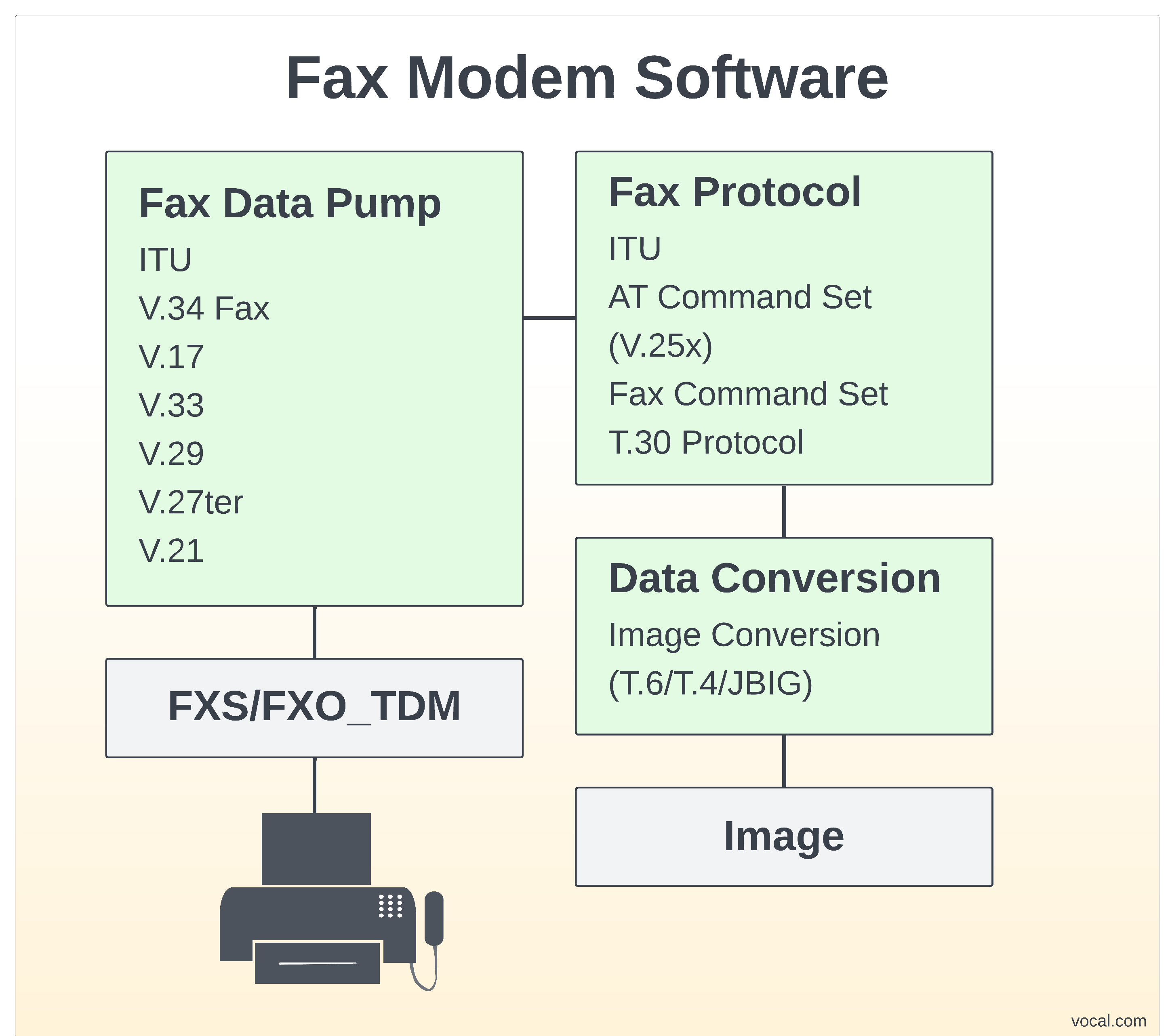
T.30 Fax software provides complete control of Group 3 fax/facsimile transfer sessions. T.30 fax protocol is a real-time implementation that can be configured to support multichannel applications. T.30 may also be used with our T.30-E color fax software. The T.30 fax software libraries are modular and can be executed as a single task under a variety of operating systems or standalone with its own microkernel.
VOCAL’s T.30 fax protocol source code is optimized for DSPs and conventional processors from ADI, TI, Intel, ARM and other vendors. Our T.30 fax software may be licensed as a standalone algorithm or library with custom designs available. Contact us to discuss your T.30 fax application requirements.
Group 3 Facsimile Modulations
The basic requirements for Group 3 facsimile refer to V.21 Channel 2 (300 bps half-duplex modulation), V.27ter (2400 and 4800 bps half duplex modulation), T.4 1-dimensional Huffman coding of images with T.30 protocol as the underlying control procedure. The image is sent with a modulation from the “High Speed” set of modulations, with V.27ter as the minimum required support.
Other Group 3 facsimile “high speed” modulations include V.29 (7200 and 9600 bps) and V.17 (7200, 9600, 12000 and 14400 bps). (Although V.29 specifies a 4800 bps modulation, it is not relevant to Group 3 facsimile.) V.33 is no longer specified as an option under T.30.
T.30 Protocol
T.30 protocol specifies an additional 14 modulation rates between 2400 bps and 33600 bps (in increments of 2400 bps) that can be used from the V.34 modulation. This is referred to as V.34 Fax. As with V.34 data modulation procedures, V.8 startup is required. V.34 Fax includes procedures for full and half duplex data channel operation; half duplex is mandatory for V.34 Fax support.
In non-V.34fax, V.21 is used to transport T.30 protocol control information frames. V.34 half-duplex procedures define a 1200 and 2400 bps control channel. In V.34 Fax, this control channel is used to transport T.30 control information frames. The use of error correction mode for V.34 Fax is mandatory.
T.30 protocol allows for manufacturer specific Non-Standard Facilities (NSF) including NSF Commands (NSC) and NSF Setup (NSS) negotiation so that compatible fax units can use the manufacturer’s proprietary methods.
Advanced features of Group 3 include other image compression algorithms such as T.4 2-dimensional coding, T.6, JPEG gray scale and color modes. Image format conversion, although not specified by T.30 protocol, is an optional feature of facsimile service class 2 command sets. Binary file transfer (BFT), is a mechanism to transport a T.454 format file under error correction.
Features
- Supports control of facsimile high speed modulations up to V.34 Fax 33,600 bps.
- T.30 session control and negotiation
- Automatic detection of NSF / NSC / NSS non-standard signaling
- Supports fax polling operation
- Supports procedure interrupts
- Optional Error Correction Mode (ECM) available
- Optional Binary File Transfer (BFT) available
- T.4 1-dimensional Image Decoding/Reencoding
- T.4 2-dimensional/ T.6 Image Decoding/Reencoding available
- In-band data format conversion support available
- Multi-tasking environment compatible
Configuration
- Configurable for standalone operation (no command set layer required).
- Facsimile Relay / Facsimile-Over-IP (T.Ifax2) available
- Error Correction Mode memory can be maintained off-system. (Recent modifications to the T.30 specification have reduced the ECM memory size requirement from 64k bytes to 16k bytes, however 64k bytes is still recommended for backward compatibility.)
- Facsimile service class 2 command sets such as T.32 “class 2.1”, EIA-592 “class 2.0” and industry standard “class 2” are available.
- Multiple protocol ports can be executed on a single DSP.
- VOCAL’s Overall Modem Controller (OMC) Layer provides coordinated data modem/ facsimile operation relative to dialing procedures, Data/Facsimile/Voice Distinction upon startup.
- Supports overlay of data and facsimile protocol memory space where applicable.

VOCAL’s solution is available for the above platforms. Please contact us for specific supported platforms.